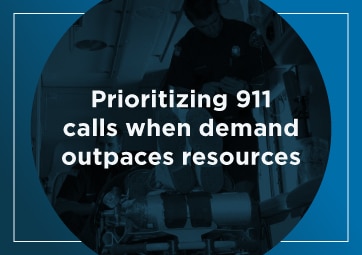Long, physically demanding hours coupled with life-and-death decision-making can lead to more than just burnout for first responders. Nearly 22% of all fire service members are expected to experience PTSD at some point in their careers. Due to this, protecting your team members’ wellbeing should be a top priority for EMS agencies and fire departments alike, right up there with their physical safety.
Critical incident reporting metrics are designed to measure the events that have the most potential to be psychologically traumatizing for first responders and are closest linked to PTSD and suicide. While the list is not exhaustive and critical incidents can vary from person to person, their documentation is crucial for protecting your own team and further improving research for the entire industry.
Here are the nine psychologically traumatizing events (PTE) you should be documenting:
- Serious injury or line-of-duty death
- Suicide of a co-worker
- Death or serious injury to a child
- Prolonged failed rescue
- Multi-casualty incident disaster
- The victim is known to the responder
- Any incident where the personal safety of the responder is jeopardized
- Incidents with excessive media interest
- Any incident with a powerful emotional component
It’s important to note that nearly 79% of records did not mention the circumstances surrounding critical incidents, which means there is a major opportunity for improving documentation. This could be in part due to the fact there is still a stigma around mental health within first response.
So, what else can your organization do?
With the alarming rise in suicide amongst first responders, the tracking of critical incidents should be a top priority within your organization and is one of many steps you can take toward improving the wellbeing of your team. Below are some recommended best practices as outlined in the 2024 ESO Fire Service Index and 2024 ESO EMS Index.
- Cultivate a supportive organizational culture where team members feel comfortable reporting critical incident exposure. Put organizational procedures and zero-harassment policies in place to promote a positive atmosphere of respect, fairness, and employee appreciation.
- Documenting exposure to critical incidents is key. Enable incident tracking and take action when any events are reported. Ask clinicians how they prefer to be contacted when an incident occurs.
- Consult the 2022 Public Safety Officer Support Act, which provides line-of-duty benefits for first responders experiencing PTSD due to critical incident exposure.
- Since critical incidents can differ from person to person, provide training to your entire team based on the latest evidence for potentially psychologically traumatizing events to help them better recognize PTSD within themselves and their peers.
- Invest in training and continuing education on delivering death notifications to ease the stress associated with performing this difficult task.
- Ensure access to appropriate mental health resources. If possible, partner with local mental health clinicians who have experience working with first responders and consider establishing peer support teams.
It’s important to remember that everyone reacts differently to the same or similar incidents, so personalize treatment to each person’s individual needs. Finally, ensure your team has the right support resources, including the National Suicide Prevention Lifeline (1-800-273-TALK [8255]) and pocketpeer.org.
For more insights regarding improving your response to critical incidents, check out the 2024 ESO Fire Service Index and the 2024 ESO EMS Index.



